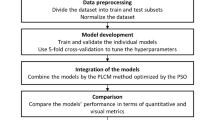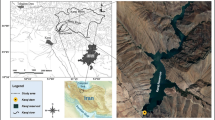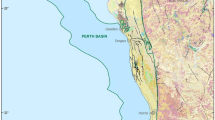Abstract
Rate of penetration (ROP) is an important parameter affecting the drilling optimization during well planning. This is particularly important for offshore wells because, offshore rigs contain daily expensive cost and therefore ROP plays a critical role in minimizing time and cost of drilling. There are many factors that affect the ROP such as mud, formation, bit and drilling parameters. In the first step of this study, the best parameters to predict ROP, are selected by error analysis of multivariate regression and then ROP modeling is performed by means of various support vector regression (SVR) methods. Fundamental difference between the individual models is type of kernel function. Finally, a committee machine is constructed in power law framework and it is optimized with imperialist competitive algorithm (ICA). This novel technique is called committee support vector regression based on imperialist competitive algorithm (CSVR-ICA) in this study. Data set are gathered from three jack-up drilling rigs. Results show that CSVR-ICA model improved the results of individual SVR models and it has a good performance in the ROP estimation.






Similar content being viewed by others
References
Afshar M, Gholami A, Asoodeh M (2014) Genetic optimization of neural network and fuzzy logic for oil bubble point pressure modeling. Korean J Chem Eng 31:496–502
Al-Anazi AF, Gates ID (2010) Support vector regression for porosity prediction in a heterogeneous reservoir: a comparative study. Comput Geosci 36:1494–1503
Ansari HR (2014) Use seismic colored inversion and power law committee machine based on imperial competitive algorithm for improving porosity prediction in a heterogeneous reservoir. J Appl Geophys 108:61–68
Ansari HR, Gholami A (2015) Robust method based on optimized support vector regression for modeling of asphaltene precipitation. J Pet Sci Eng 135:201–205
Arabjamaloei R, Shadizadeh SR (2011) Modeling and optimizing rate of penetration using intelligent systems in an iranian southern oil field (Ahwaz Oil Field). Pet Sci Technol 29:1637–1648
Arabloo M, Ziaee H, Lee M, Bahadori A (2015) Prediction of the properties of brines using least squares support vector machine (LS-SVM) computational strategy. J Taiwan Inst Chem Eng 50:123–130
Asoodeh M, Bagheripour P (2012) Estimation of bubble point pressure from PVT data using a power-law committee with intelligent systems. J Pet Sci Eng 90:1–11
Asoodeh M, Gholami A, Bagheripour P (2014) Asphaltene precipitation of titration data modeling through committee machine with stochastically optimized fuzzy logic and optimized neural network. Fluid Phase Equilib 364:67–74
Atashpaz-Gargari E, Lucas C (2007) Imperialist competitive algorithm: an algorithm for optimization inspired by imperialistic competition. IEEE Congress on Evolutionary Computation, Singapore, pp 4661–4666
Atashpaz-Gargari E, Hashemzadeh F, Rajabioun R, Lucas C (2008) Colonial competitive algorithm, a novel approach for PID controller design in MIMO distillation column process. Int J Intell Computing Cybern 1:337–355
Bagheripour P, Gholami A, Asoodeh M, Vaezzadeh-Asadi M (2015) Support vector regression based determination of shear wave velocity. J Pet Sci Eng 125:94–99
Bahari A, Baradaran SA (2009) Drilling cost optimization in a hydrocarbon field by combination of comparative and mathematical methods. Pet Sci 6:451–463
Bahari MH, Bahari A, Nejati Moharrami F, Naghibi Sistani MB (2008) Determining Bourgoyne and Young model coefficients using genetic algorithm to predict drilling rate. J Appl Sci 8:3050–3054
Bilgesu HI, Tetrick LT, Altmis U, Mohaghegh S, Ameri S (1997) A new approach for the prediction of rate of penetration values. Paper presented at SPE Eastern Regional Meeting, Lexington, USA
Boser BE, Guyon IM, Vapnik V (1992) A training algorithm for optimal margin classifiers. In: Haussler D (ed) Proceedings of the annual workshop on computational learning theory. ACM, New York, pp 144–152
Bourgoyne AT, Young FS (1974) A multiple regression approach to optimal drilling and abnormal pressure detection. Soc Pet Eng J 14:371–384
Bourgoyne AT, Millheim KK, Chenevert ME, Young FS (2003) Applied drilling engineering, 9th edn. SPE, Richardson
Chen CH, Lin ZS (2006) A committee machine with empirical formulas for permeability prediction. Comput Geosci 32:485–496
Cortes C, Vapnik V (1995) Support vector networks. Mach Learn 20:273–297
Deng S, Yeh TH (2010) Applying least squares support vector machines to the airframe wing-box structural design cost estimation. Expert Syst Appl 37:8417–8423
Fletcher R (1989) Practical methods of optimization. Wiley, New York
Flores BE (1986) A pragmatic view of accuracy measurement in forecasting. Omega 14:93–98
Gencoglu MT, Uyar M (2009) Prediction of flashover voltage of insulators using least squares support vector machines. Expert Syst Appl 36:10789–10798
Ghiasi-Freez J, Kadkhodaie-Ilkachi A, Ziaii M (2012) Improving the accuracy of flow units prediction through two committee machine models: an example from the South Pars Gas Field, Persian Gulf Basin, Iran. Comput Geosci 46:10–23
Gholami A, Moradi S, Dabir B (2013) A power law committee scaling equation for quantitative estimation of Asphaltene precipitation. Int J Sci Emerg Technol 6:275–283
Kadkhodaie-Ilkhchi A, Rezaee MR, Rahimpour-Bonab H, Chehrazi A (2009) Petrophysical data prediction from seismic attributes using committee fuzzy inference system. Comput Geosci 35:2314–2330
Kaiser M (2007) A survey of drilling cost and complexity estimation models. Int J Pet Sci Tech 1:1–22
Lummus JL (1970) Drilling optimization. J Pet Technol 22:1379–1388
Na’imi SR, Shadizadeh SR, Riahi MA, Mirzakhanian M (2014) Estimation of reservoir porosity and water saturation based on seismic attributes using support vector regression approach. J Appl Geophys 107:93–101
Rajabioun R, Atashpaz-Gargari E, Lucas C (2008) Colonial competitive algorithm as a tool for nash equilibrium point achievement. Lect Notes Comput Sci 5073:680–695
Russell BH (2004) The application of multivariate statistics and neural networks to the prediction of reservoir parameters using seismic attributes. Dissertation, University of Calgar
Suykens JAK, Van Gestel T, De Brabanter J, De Moor B, Vandewalle J (2002) Least squares support vector machines. Singapore World Scientific Pub Co, Singapore
Vapnik V (1995) The nature of statistical learning theory, 2nd edn. Springer, New York
Vapnik V (1998) Statistical learning theory. Wiley, New York
Vapnik V, Golowich S, Smola A (1997) Support vector method for function approximation, regression estimation, and signal processing. In: Mozer MC, Jordan MI, Petsche T (eds) Advances in neural information processing systems. MIT Press, Cambridge, pp 281–287
Author information
Authors and Affiliations
Corresponding author
Rights and permissions
About this article
Cite this article
Ansari, H.R., Sarbaz Hosseini, M.J. & Amirpour, M. Drilling rate of penetration prediction through committee support vector regression based on imperialist competitive algorithm. Carbonates Evaporites 32, 205–213 (2017). https://doi.org/10.1007/s13146-016-0291-8
Accepted:
Published:
Issue Date:
DOI: https://doi.org/10.1007/s13146-016-0291-8




